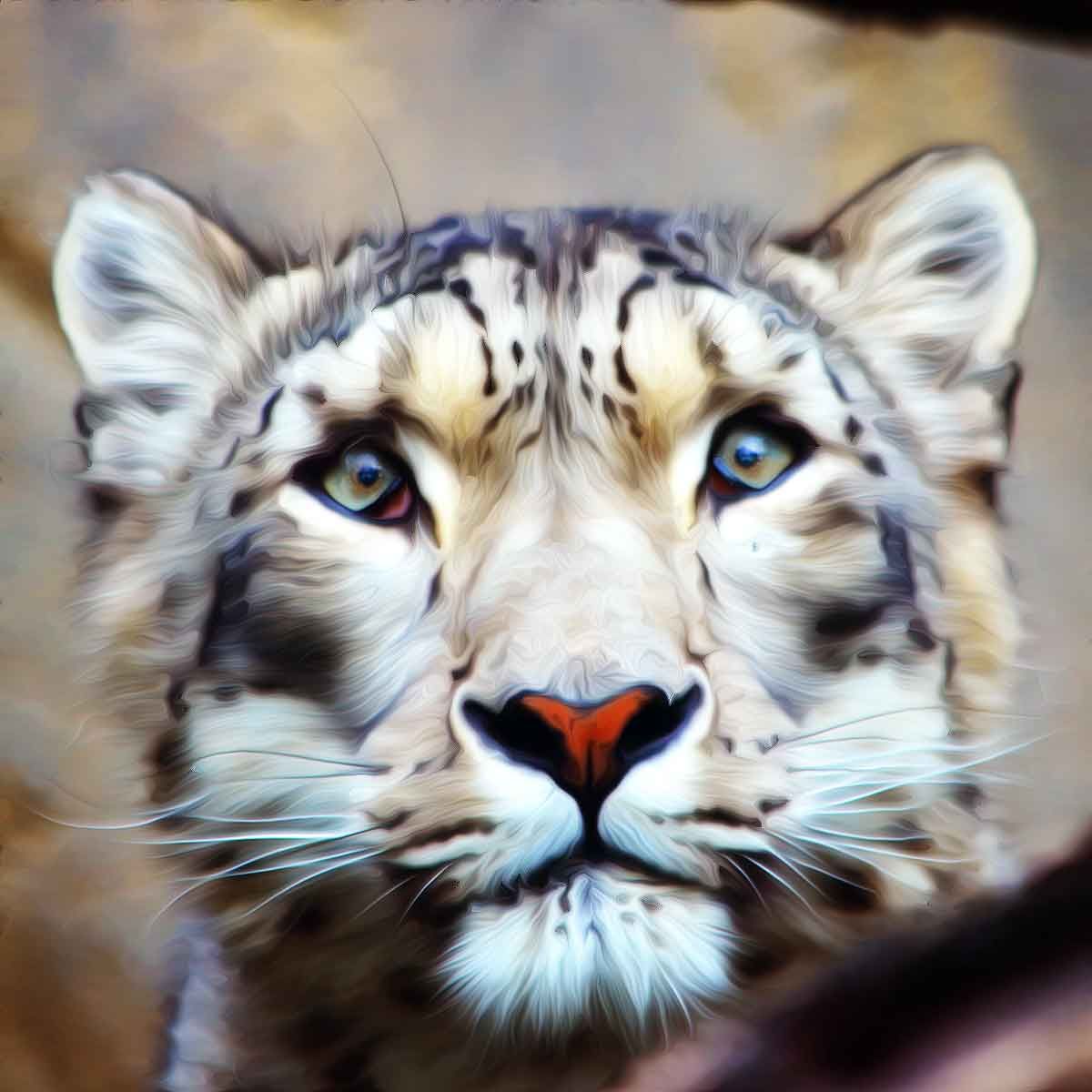More Coverage
Twitter Coverage
Satyaagrah
Written on
Satyaagrah
Written on
Satyaagrah
Written on
Satyaagrah
Written on
Satyaagrah
Written on
JOIN SATYAAGRAH SOCIAL MEDIA
"Each species is a masterpiece, a creation assembled with extreme care & genius": Ghost of the mountains | Snow Leopard, one of the most agile hunters on earth is an elusive mammal species of cat family, top-predator of Central Asia & Indian Himalaya

The strikingly beautiful snow leopard remains one of the most mysterious cats in the world.
|
Highly adapted to life on the cold, rocky slopes of High Asia the snow leopard is a master of stealth and camouflage. Very rarely seen by humans, it has come to be known as the ‘ghost of the mountains. It has also become an icon for these breathtaking and critically important landscapes, which house a diverse array of unique high-altitude species and provide critical ecosystem services for hundreds of millions of people. It is estimated that over 330 million people live within 10km of rivers originating in snow leopard habitats and are directly affected by the water flowing down from these mountains.
Snow leopards roam across vast swathes of the region’s mountainous terrain, with individual home ranges stretching from 200 to 2000 km2. This roving, high-altitude cat is rarely sighted, and because it is so elusive, accurate population numbers are hard to come by, although estimates range from 400 to 700 individuals in India.
The Government of India has identified the snow leopard as a flagship species for the high-altitude Himalayas. It has developed a centrally-supported program called Project Snow Leopard to conserve the species and habitats. Currently, Snow Leopard Population Assessment in India (SPAI) is being undertaken by the MoEFCC, Govt of India. WWF India is working with the MoEFCC and the state forest departments of Arunachal Pradesh and Sikkim for this assessment.
|
Ecology and Conservation Issues in India
Several species have lost their habitats, and once contiguous wildlife habitats have been severely affected by human pressures globally. Across different ecosystems, numerous species today face large-scale range contraction and extinction. The risk of extinction for a species is driven by a combination of its life history traits, ecological factors, an array of natural biotic and abiotic factors, and anthropogenic disturbances. Among all animals, large mammals are particularly more vulnerable to local extinctions due to their body size, high food requirements, and need for larger spaces. Within large mammals, large carnivores especially, require a considerable area for hunting, finding mates, and maintaining territories. Carnivores also face retribution killing under any circumstances due to interaction with humans, as they often inflict losses through livestock depredation. Large carnivores are often considered to be the ‘umbrella’ or ‘flagship’ species that govern the dynamics of an ecosystem.
However, due to their large-ranging nature and elusive characteristics, gathering reliable ecological information at a large spatial scale is extremely challenging in the case of most large carnivores. The deficiency of reliable information significantly hinders carnivore conservation since conservation efforts need to be implemented at large spatial scales. India has an exceptionally rich and highly diversified flora and fauna, exhibiting complex composition, characteristics, and affinities. Over the past century, land-use changes and human population growth have severely affected most Indian mammal species and their habitats. About 20% of large Indian mammals face extinction, and many others have lost over 90% of their historical range.
In comparison to many large mammals of the Indian tropics, our knowledge of the ecology and conservation issues of high-altitude large mammalian assemblage remains limited. One of the most charismatic and endangered species among large carnivorous mammals found in the Indian Himalayas is the snow leopard (Panthera uncia). The snow leopard is the top predator of the Indian Himalayas and the Trans-Himalayas, playing an important role in maintaining the food chain dynamics of the high-altitude ecosystem. That is why the snow leopard is considered the umbrella species for the conservation of wildlife in the Indian Himalayas and the Trans-Himalayas.
|
Snow Leopard: Ecology
Snow leopards are generally solitary animals, yet groups of up to six snow leopards have been reported. During camera trapping in the Spiti Valley of Himachal Pradesh, up to four snow leopards have been captured in a single frame (Figure 3). They mate during winter, usually between January and March. During this period, snow leopards mark their territories intensively using scent spray, scraping, claw raking, and scat. These social markings are made along their trails and are usually found along or close to prominent landform features such as ridgelines, cliff bases, large boulders, and the confluence of streams (Figure 4). The gestation period in snow leopards is between 93 to 110 days. Litter size may vary between one to five cubs. Cubs are generally born between June and July (peak summer).
Home Range and Movement
The snow leopard is a large-ranging species with overlapping home ranges. A study in Nepal, based on data from five snow leopards showed that their home ranges varied between 12 to 39 km2 with substantial overlap between individuals and among sexes. Home ranges of snow leopards have been reported to be very different and are usually much larger in Central Asia. In Mongolia, reported home ranges of both males and females were greater than 400 km2, and often more than 1,000 km2. This is potentially due to the low availability of food resources in the desert landscape. Intensive camera trapping across a 4,000 km2 area in Spiti Valley in Himachal Pradesh, showed an average home range size of 130 km2.
Individual snow leopards have been observed to cover straight-line distances of 1 to 2 km between consecutive days, but may also undertake periodic long-distance travels of more than 20 km within a single day. Research suggests that a snow leopard remains within a relatively small area for a week to 10 days. Following this period, the activity-core shifts to another distant part of its home range, perhaps in response to the availability of wild prey species. Several studies suggest that snow leopards mark their core areas significantly more than other areas within the home range. This suggests that social marking has an important role to play in spatially separating individuals.
|
Prey, Diet, and Depredation
Major wild preys of the snow leopard are ibex, bharal or blue sheep, Himalayan tahr (Hemitragus jemlahicus), argali (Ovis ammon), and marmots (Marmota spp.). Blue sheep and ibex constitute the primary prey species of snow leopards across its global distribution range. Apart from these, snow leopards also prey on urial (Ovis spp.), red deer or hangul (Cervus elaphus), roe deer (Capreolus pygargus), and musk deer (Moschus spp.). Snow leopards also consume vegetation, and scat has been reported to contain only twigs. Wild prey may contribute between 45%–98% to the snow leopard diet.
In some areas, domesticated livestock constitutes a major part of the snow leopard diet (between 40%–70%), though usually, livestock contribution remains between 15%–30%. Snow leopards may inflict considerable losses on herders and local communities through livestock depredation. Loss of 3%– 18% of local livestock holdings annually to snow leopards have been reported from certain Himalayan areas. As mentioned above, the overall contribution of livestock to the snow leopard diet could be as high as 70% and include large-bodied livestock (e.g., horses, donkeys) as well. In the Tibetan Plateau, losses of livestock averaging about 2% per village and up to 9.5% in some sites have been recorded. A study in Nepal’s Annapurna Conservation Area found livestock remains in about 18% of snow leopard scat samples collected. This percentage soared to 39% in winter, potentially due to the scarcity of food sources owing to marmot hibernation, deep snow, and yak herds relatively hurdling more together during winter. Livestock depredation by snow leopards continues to be a major challenge in the coexistence of humans and snow leopards.
|
Conservation Challenges in the Himalayas
The Indian Himalayas and the Trans-Himalayas form the southern limits of the global distribution range of snow leopards, and are home to about 10% of the global population (estimated at about 7,500), in less than 5% of its global range. Snow leopards mostly occur at low densities throughout their range (about one snow leopard per 100 km2). In India, snow leopards occur almost contiguously across 1,00,000 km2 of the alpine zone of the Himalayas and the Trans-Himalayas above elevations of about 3,000 m in the Western Himalayas and about 4,000 m in the Eastern Himalayas. A recent national scale assessment shows that 95% of the potential snow leopard range in India is yet to receive any research attention, and about 80% of its habitat is unprotected.
The overall snow leopard population estimate for India, according to this study, is around 500 individuals. The potential habitat of snow leopards across the Greater and Trans-Himalayan landscape, in general, is experiencing drastic socio-economic changes over the past few decades. Major changes have been documented in the Spiti Valley of the Lahaul and Spiti district, owing to the advent of green pea (Pisum sativum) cultivation during the mid-1980s and the advent of apple cultivation around the same time in the Kinnaur district.
Studies on snow leopard habitats over the past two decades show that the economy of the region has rapidly shifted from traditional agro-pastoralism to market-driven agriculture. Consequently, human population growth, agricultural expanse, and excessive livestock grazing have been pervasive in the region. Developmental activities like hydroelectric projects, road constructions, and tourism activities in prime habitats of snow leopards have opened up remote and hitherto undisturbed areas, increasing human access and pressures. Increasing job opportunities through infrastructure development projects are attracting laborers from distant places who differ socio-economically and culturally from the local inhabitants.
These changes over the years and growing human needs have resulted in a gradual erosion of traditional tolerance; especially towards the snow leopard (for livestock depredation) and wild herbivores (for crop raiding and forage competition with the livestock). Many of the traditional threats are getting replaced by new and more devastating ones such as poaching by nonnative laborers, habitat fragmentation due to the fencing of agricultural lands, forage competition with wild herbivores due to intense and unchecked grazing (Box 1), etc. A rapidly increasing tourism infrastructure in villages and townships and the ensuing mismanagement of garbage are aiding in an increase in the population of free-ranging/feral dogs.
Feral dogs are hunting in packs out in the wild for blue sheep and ibex and pose a serious threat to solitary species like snow leopards. Deprivation of prey species continues to be a primary threat to snow leopards in parts of the Greater Himalayas and some areas of Trans-Himalayas. The snow leopard habitat faces considerable threat from climate change as well. Climate change predictions suggest that about a third of the snow leopard habitat is vulnerable to a shift in the tree line and the resulting shrinkage of alpine habitat in the Himalayas. Additionally, owing to the remote and rugged terrain of the snow leopard habitat, monitoring snow leopards and wild prey populations is extremely challenging.
For the same reasons, protecting and patrolling snow leopard habitats to prevent illegal activities even in protected areas (PAs) is time and effort intensive, thus, often hardly feasible. Most conventional monitoring and survey techniques applied in the tropics (e.g., line transect and distance sampling methods for prey density estimation, and capture–mark–recapture technique for carnivore population estimation) prove to be costly and require to be modified for the mountainous terrain to be efficient. Finally, there is an enormous limitation of trained professionals (biologists, researchers, and managers) in the field of high-altitude ecology and conservation in India; especially pertaining to snow leopards. The nodal agencies mandated with the task of habitat management and conservation – the State Forest or Wildlife Departments – are often understaffed, inadequately trained, and resource constrained.
|
Conservation Action
Snow leopards have been given the highest level of legal protection in India under the Indian Wildlife (Protection) Act, of 1972. Also, India is a signatory to the Convention on International Trade in Endangered Species of Wild Fauna and Flora (CITES) and the Convention on the Conservation of Migratory Species of Wild Animals (CMS), providing additional protection to the snow leopard. Since the late 1990s, based on research and in partnership with local forest departments, different forms of specific conservation interventions were initiated especially in Ladakh (Jammu and Kashmir) and Spiti (Himachal Pradesh) regions.
These steps include improved livestock corrals to reduce depredation, livestock insurance programs to compensate for livestock loss to the local community, and the establishment of grazing-free reserves to increase the wild prey population. The most recent forms of participatory local conservation initiatives are those of ‘Snow Leopard Enterprise’ (SLE) which focuses on empowering local women by facilitating the production of ‘wildlife friendly’ wool products, and engagement of snow leopard conservationists with pashmina wool growers to develop sustainable grazing practices for pashmina production and trade. The uniqueness of the Indian snow leopard habitat from other tropical ecosystems is the widespread occurrence of wildlife across the mountainous landscape.
Here, nature is not limited to the protected areas but coexists with humans in multiple-use landscapes. Owing to this feature of the distribution range of snow leopards and the vast interface with local communities, the Government of India launched a landscape-level participatory conservation program for the Indian high-altitudes called the ‘Project Snow Leopard’ (PSL) in 2009.
The framework of PSL allows the conservation of multiple-use large landscapes even outside PAs. Over the past decade, the snow leopard range countries have joined hands to develop national and transboundary conservation initiatives in the form of National Snow Leopard Ecosystem Priority Protection (NSLEP), Snow Leopard Survival Strategy (SLSS), and Global Snow Leopard and Ecosystem Protection Program (GSLEP).
As part of GSLEP, two large landscapes have been identified in India across Himachal Pradesh, Ladakh (Jammu & Kashmir), and Uttarakhand to secure breeding populations of snow leopards. Institutions and organizations working towards enhancing knowledge on snow leopard ecology and its conservation in India include (but may not be restricted to) the Wildlife Institute of India, Nature Conservation Foundation – Snow Leopard Trust, World Wildlife Fund for Nature – India (WWF), and Snow Leopard Conservancy
|
References:
- M D Madhusudan and C Mishra, Why Big, Fierce Animals are Threatened: Conserving Large Mammals in Densely Populated Landscapes, Battles Over Nature: Science and Politics of Conservation, Eds. V Saberwal & M Rangarajan, pp.31-55, Permanent Black, New Delhi, 2003
- Lyngdoh et al., Prey Preferences of the Snow Leopard ( Panthera uncia): Regional Diet Specificity Holds Global Significance for Conservation, PLoS ONE 9(2): e88349. doi:10.1371/journal.pone.0088349, 2014
- RS Chundawat and R S Rawat, Food Habits of Snow Leopard in Ladakh, India, 1994, pp.127–132 in: J L Fox and Du Jizeng (Eds), Proceedings of the Seventh International Snow Leopard Symposium, (Xining, Qinghai, China, July 25–30, 1992), International Snow Leopard Trust, Seattle, Washington
- Suryawanshi et al., People, Predators, and Perceptions: Patterns of Livestock Depredation by Snow Leopards and Wolves, Journal of Applied Ecology, Vol.50, No.3, pp.550–560, 2013
- M Kohli, M Sankaran, K R Suryawanshi, and C Mishra, A Penny Saved is a Penny Earned: Lean Season Foraging Strategy of an Alpine Ungulate, Animal Behaviour, Vol.92, pp.93–100, 2014.
- J Berger, B Buuveibaatar, and C Mishra, Globalization of the Cashmere Market and the Decline of Large Mammals in Central Asia, Conservation Biology, Vol.27, No.4, pp.679–689, 2013
- Ghoshal et al., Response of the Red Fox to Expansion of Human Habitation in the Trans-Himalayan Mountains, European Journal of Wildlife Research, Vol.62, pp.131–136, 2016
- The Project Snow Leopard, Ministry of Environment & Forests, Government of India, New Delhi, 2008
- Snow Leopard Network – Snow Leopard Survival Strategy, Revised 2014 Version Snow Leopard Network, Seattle, Washington, USA, 2014
 Support Us
Support Us
Satyagraha was born from the heart of our land, with an undying aim to unveil the true essence of Bharat. It seeks to illuminate the hidden tales of our valiant freedom fighters and the rich chronicles that haven't yet sung their complete melody in the mainstream.
While platforms like NDTV and 'The Wire' effortlessly garner funds under the banner of safeguarding democracy, we at Satyagraha walk a different path. Our strength and resonance come from you. In this journey to weave a stronger Bharat, every little contribution amplifies our voice. Let's come together, contribute as you can, and champion the true spirit of our nation.
 |  |  |
| ICICI Bank of Satyaagrah | Razorpay Bank of Satyaagrah | PayPal Bank of Satyaagrah - For International Payments |
If all above doesn't work, then try the LINK below:
Please share the article on other platforms
DISCLAIMER: The author is solely responsible for the views expressed in this article. The author carries the responsibility for citing and/or licensing of images utilized within the text. The website also frequently uses non-commercial images for representational purposes only in line with the article. We are not responsible for the authenticity of such images. If some images have a copyright issue, we request the person/entity to contact us at satyaagrahindia@gmail.com and we will take the necessary actions to resolve the issue.
Related Articles
- "A leap in Ladakh, a legacy for the world": India propels into a green future, launching its pioneering hydrogen bus trials in Ladakh, a bold leap in green energy, setting a global benchmark in combating climate change through innovative initiatives
- "Every train has a story to tell, and it whispers its secrets to those who listen with their hearts": Historic Kalka-Shimla train undergone a remarkable makeover with the introduction of indigenous Vistadome coaches resembling famous Swiss Bernina Express
- "Look deep into nature, then you will understand everything better": Malabar giant squirrel (also known as shekru), an all-natural technicolor coat endemic to India, stretch as much as 3 feet long—longer than eastern gray squirrel & svelter counterparts
- "A mystic Himalayan Griffon is a bird who separates heaven and earth with his wings": A rare vulture was captured in Eidgah cemetery of Kanpur's Colonelganj, locals handed it over to Forest Department after capturing it, had been there for a week
- "There is no index of character so sure as the voice": Pahadi Mayna of Chhattisgarh reproduce an exact pronunciation as humans at times, it begin to learn human speech sounds under social relationships, for bird to talk you must intrude on its social life
- In one of the rarest incidents wild mother elephant gave birth to twins in the Bandipur Tiger Reserve: Soon after the birth, the two toddlers joined their mother back in the herd
- “If you would know strength & patience, welcome the company of trees”: “Trees for Wealth” - first-of-its-kind movement to bring about a revolution in the local economy & has envisioned State as the ‘Fruit Hub of India' by planting 1 billion fruit trees
- Explained: China’s Village Construction In Bhutan’s Territory And What It Wants To Achieve With This Creeping Invasion
- @BROindia, on the cusp of outdoing its own world record with Umling La at 19024 feet, now spearheads the Likaru-Migla-Fukche project, this strategic route, traversing 19400 feet at Migla, epitomizes India's unwavering ambition and engineering prowess
- “You need mountains, long staircases don’t make good hikers”: Kalavantin Durg - one of the steepest fortresses in Maharashtra 2,300 feet high trek up this fort is called ‘Climb to Heaven’ because it involves rugged terrain & climbing narrow rock-cut steps
- "It is not actual suffering but taste of better things which excites people to revolt": After Rajasthan revolt, nervous Congress decides to field all sitting MLAs in Himachal poll, CEC headed by Sonia Gandhi decides not to deny tickets to any of its MLAs
- "From the heart of Himachal, gratitude emerges": After decades of waiting, Himachal’s Hatti community revels in tribal recognition, sending gratitude to PM Modi, a testament to their unwavering spirit and the mountains of Sirmaur that stood witness
- "The reward for work well done is the opportunity to do more": Patayat Sahu, from Kalahandi spent his entire life making an astonishing garden of 3000 medicinal plants and catalogued them in two illustrated volumes, this year’s recipient of Padma Shri
- “If it looks like a duck, quacks like a duck, it's a duck”: Mandarin duck is considered one of the most beautiful birds in the world, this is because of its stunning plumage, which is made up of an array of colors that you can't help but notice them
- "And Freya the walrus, you slept your last because we loved you too much": Freya killed by Norwegian authorities after becoming a victim of her own popularity, 1320-pound female walrus was put down as an assessment concluded threat to human safety"




























